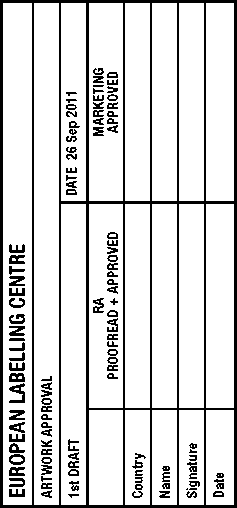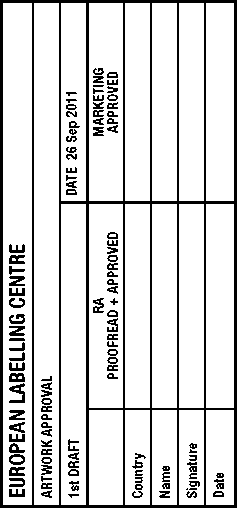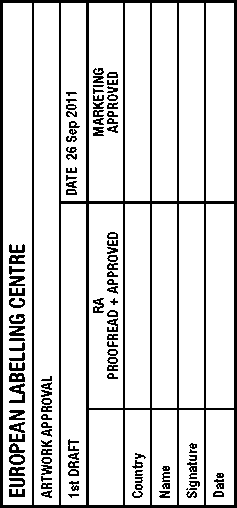Water For Injections
Out of date information, search anotherPACKAGE LEAFLET: INFORMATION FOR THE USER Water for Injections Ph. Eur.
In this leaflet:
1. What Water for Injections is and what it is used for
2. Before you use Water for Injections
3. How to use Water for Injections
4. Possible side effects
5. How to store Water for Injections
6. Further information
01738
Read all of this leaflet carefully before you start using this medicine.
• Keep this leaflet. You may need to read it again.
• If you have any further questions, ask your doctor or pharmacist.
• This medicine has been prescribed for you. Do not pass it on to others. It may harm them, even if their symptoms are the same as yours.
• If any of the side effects gets serious, or if you notice any side effects not listed in this leaflet, please tell your doctor or pharmacist.
This medicine is called Water for Injections Ph. Eur., but will be referred to as Water for Injections throughout the remainder of this leaflet.
1. What Water for Injections is and what it is used for
Water for Injections is pure, sterile water. It is used to dilute medicines before use. For example medicines that are given by:
• injection (given using a needle, for example into your vein)
• infusion (slow injection) into a vein, also called a ‘drip’.
2. Before you use Water for Injections
You must NOT receive Water for Injections on its own. If injected into your bloodstream on its own it can cause your red blood cells to take in water and burst (haemolysis). This is because Water for Injections does not have the same consistency as your blood.
Water for Injections will always be mixed with one or more medicines by a healthcare professional before you receive it.
You should read the Patient Information Leaflet of your medicine or medicines that are being mixed with Water for Injections. These will tell you whether or not you can receive the solution.
o
Take special care with Water for Injections
Water for Injections should not be used on its own. Before you use Water for Injections:
• it will always be mixed with one or more medicines
• your healthcare professional will make sure that the mixture is roughly the same consistency as your blood (isotonic). Depending on the type of medicine you are given this will mean that:
- the medicine needs to be diluted with Water for Injections
- another substance needs to be added to your mixture of Water for Injections and medicine before use.
You will be more likely to suffer haemolysis if you are given large volumes of hypotonic solutions of Water for Injections (solutions that are not as concentrated as your blood).
To help prevent this, your doctor will take a blood sample to monitor the balance of the chemicals in your blood (the ionic balance).
Before you are given medicines mixed with Water for Injections your doctor will check that:
• the medicines are stable in Water for Injections
• the medicines will not interact with each other
Taking other medicines
Please tell your doctor or pharmacist if you are taking or have recently taken any other medicines, including medicines obtained without a prescription.
The medicines you are using mixed with Water for Injections may interact with each other.
Using Water for Injections with food and drink
You should ask your doctor about what you can eat or drink.
Pregnancy and breast-feeding
Ask your doctor or pharmacist before taking any medicine. Please tell your doctor if you are pregnant or breast-feeding.
Any risk to your unborn baby or your pregnancy will depend on which medicines you are using mixed with Water for Injections. Any risk to your baby during breast-feeding will also depend on which medicines you are using mixed with Water for Injections.
Your doctor will be able to advise you on what risks are involved in taking particular medicines.
Your doctor will only give you medicines during pregnancy or breast-feeding if it is essential.

|
RA Proofreading Checklist | |||
|
Product name,strength,composition (API & excipients) |
Consistency check with all figures cited in the product information |
Storage Conditions and Shelf-Life | |
|
Product Information proofread as per RA SOP CE-RAPV-009 |
Compliance with National Regulations |
Barcodes, Symbols and Reimbursement Information |
Driving and using machines
Water for Injections does not affect your ability to drive or use machines.
Any effects on your ability to drive or use machines will depend on which medicines you are using mixed with Water for Injections. Your doctor will be able to advise you on this.
3. How to use Water for Injections
Water for Injections will be given to you by a doctor or nurse.
Your doctor will decide on how much you need and when and how it is to be given. This will depend on which medicine or medicines you need to take with Water for Injections.
Your doctor will also consider your age, weight, condition and what other treatments you are receiving.
You should NOT be given Water for Injections if there are particles floating in the water or if the pack is damaged in any way.
If you use more Water for Injections than you should
If you are given too much Water for Injections (over-infusion) this may lead to haemolysis. Haemolysis is when your red blood cells take in water and burst.
The medicines mixed with Water for Injections may also cause symptoms if administered in too large quantities (over-infusion). Any signs and symptoms of overdose will depend on which medicines you are using mixed with Water for Injections.
If you are accidentally given an overdose your treatment will be stopped and you will be given treatment depending on the symptoms.
You should read the Patient Information Leaflet of the medicines mixed with Water for Injections for a list of possible symptoms of over-infusion.
If you have any further questions on the use of this product, ask your doctor.
4. Possible side effects
Like all medicines, Water for Injections can cause side effects, although not everybody gets them.
You may suffer bursting (haemolysis) of your red blood cells if:
• you use Water for Injections on its own
• Water for Injections is used to make solutions for injection or infusion that are not of a similar consistency to your blood (isotonic).
If a medicine has been added to Water for Injections, the added medicine may also cause side effects. These side effects will depend on the medicine that has been added. You should read the Patient Information Leaflet of the added medicine for a list of possible symptoms.
If you notice any side effects or are concerned about anything, please tell your doctor or nurse.
5. How to store Water for Injections
Keep out of the reach and sight of children.
Do not remove Water for Injections from the outer plastic overpouch until it is to be used.
Water for Injections should NOT be given to you after the expiry date which appears on the bag. The expiry date refers to the last day of that month.
Once the pack is opened Water for Injections should be used straight away.
6. Further information
What Water for Injections contains
The only ingredient is sterile water for injections.
Each bag contains 100% sterile water for injections.
What Water for Injections looks like and contents of the pack
Water for Injections is a clear solution, free from visible particles.
It is supplied in polyolefin/polyamide plastic bags (VIAFLO). Each bag is wrapped in a sealed, protective, outer plastic overpouch.
|
The bag sizes are: | |
|
• |
50 ml |
|
• |
100 ml |
|
• |
250 ml |
|
• |
500 ml |
|
• |
1000 ml |
The bags are supplied in cartons. Each carton contains one of the following quantities:
• 50 bags of 50 ml
• 50 bags of 100 ml
• 30 bags of 250 ml
• 20 bags of 500 ml
• 10 bags of 1000 ml
Not all pack sizes may be marketed.

|
RA Proofreading Checklist | |||
|
Product name,strength,composition (API & excipients) |
Consistency check with all figures cited in the product information |
Storage Conditions and Shelf-Life | |
|
Product Information proofread as per RA SOP CE-RAPV-009 |
Compliance with National Regulations |
Barcodes, Symbols and Reimbursement Information |
Marketing Authorisation Holder and Manufacturer
Marketing Authorisation Holder:
Send all enquiries to this address Baxter Healthcare Ltd.
Caxton Way
Thetford Norfolk IP24 3SE United Kingdom
Manufacturers:
Baxter Healthcare Ltd.

Caxton Way Thetford
Norfolk - IP24 3SE United Kingdom
Baxter S.A.
Boulevard R. Branquart, 80 7860 Lessines Belgium
Bieffe Medital Sabinanigo Ctra de Biescas-Senegue 22666 Sabinanigo (Huesca)
Spain
Baxter Healthcare S.A.
Moneen Road Castlebar - County Mayo Ireland
This leaflet was last approved in September 2011.
For information about Water for Injections or to request this leaflet in formats such as audio or large print please contact the Marketing Authorisation Holder:
Tel: 01635 206345.

|
RA Proofreading Checklist | |||
|
Product name,strength,composition (API & excipients) |
Consistency check with all figures cited in the product information |
Storage Conditions and Shelf-Life | |
|
Product Information proofread as per RA SOP CE-RAPV-009 |
Compliance with National Regulations |
Barcodes, Symbols and Reimbursement Information |
O
0 1
CB-30-01-738
CD CD
£ &
CD CD
I §
CD Q-3 <
as os
O O
1. aj
_ CD
3
P 3
a.
CD
3
|
EUROPEAN LABELLING CENTRE | ||
|
ARTWORK APPROVAL | ||
|
1st DRAFT |
DATE 26 Sep 2011 | |
|
RA PROOFREAD + APPROVED |
MARKETING APPROVED | |
|
Country | ||
|
Name | ||
|
Signature | ||
|
Date | ||
|
RA Proofreading Checklist | |||
|
Product Information proofread as per RA SOP CE-RAPV-009 |
Product name,strength,composition (API & excipients) | ||
|
Compliance with National Regulations |
Consistency check with all figures cited in the product information | ||
|
Barcodes, Symbols and Reimbursement Information |
Storage Conditions and Shelf-Life | ||

I I

Water for Injections Ph. Eur.
The following information is intended for medical or healthcare professionals only:
Handling and Preparation
Use only if the solution is clear, without visible particles and if the container is undamaged. Administer immediately following the insertion of an infusion set.
Do not remove unit from overwrap until ready for use.
The inner bag maintains the sterility of the product.
Do not use plastic containers in series connections. Such use could result in air embolism due to residual air being drawn from the primary container before the administration of the fluid from the secondary container is completed.
Water for Injections should not be infused alone.
The infusion should be made isotonic prior to parenteral administration.
Additives may be introduced before administration or during administration through the re-sealable medication port. Thorough and careful aseptic mixing of any additive is mandatory. Solutions containing additives should be used immediately and not stored.
The infusion should be administered with sterile equipment using an aseptic technique. The equipment should be primed with the infusion in order to prevent air entering the system. Discard after single use.
Discard any unused portion.
Do not reconnect partially used bags.
The following fill volumes should be taken into consideration when preparing infusions :
59 ml for the 50 ml bag 111 ml for the 100 ml bag 271 ml for the 250 ml bag 530 ml for the 500 ml bag 1040 ml for the 1000 ml bag
1. Opening
a. Remove the VIAFLO container from the overpouch just before use.
b. Check for minute leaks by squeezing inner bag firmly.
If leaks are found, discard solution, as sterility may be impaired.
c. Check the solution for limpidity and absence of foreign matters. If solution is not clear or contains foreign matters, discard the solution.
2. Preparation for administration after rendering isotonic
a. Suspend container from eyelet support.
b. Remove plastic protector from outlet port at bottom of container:
- grip the small wing on the neck of the port with one hand,
- grip the large wing on the cap with the other hand and twist,
- the cap will pop off.
c. Use an aseptic method to set up the infusion.
d. Attach administration set. Refer to complete directions accompanying set for connection, priming of the set and administration of the solution.
3. Techniques for injection of additive medications
Warning: Additives may be incompatible:
To add medication before administration
a. Disinfect medication port.
b. Using syringe with 19 gauge (1.10 mm) to 22 gauge (0.70 mm) needle, puncture re-sealable medication port and inject.
c. Mix solution and medication thoroughly. For high-density medication such as potassium chloride, tap the ports gently while ports are upright and mix.
Caution: Do not store bags containing added medications.
To add medication during administration
a. Close clamp on the set.
b. Disinfect medication port.
c. Using syringe with 19 gauge (1.10 mm) to 22 gauge (0.70 mm) needle, puncture re-sealable medication port and inject.
d. Remove container from IV pole and/or turn to an upright position.
e. Evacuate both ports by tapping gently while the container is in an upright position.
f. Mix solution and medication thoroughly.
g. Return container to in-use position, re-open the clamp and continue administration.
4. In-use shelf-life: Additives
Chemical and physical stability of any additive at the pH of Water for Injections (4.5 to 7.0) in the container should be established prior to use.
From a microbiological point of view, the diluted product should be used immediately, unless reconstitution has taken place in controlled and validated aseptic conditions. If not used immediately, in-use storage times and conditions prior to use are the responsibility of the user.
5. Incompatibilities of additive medications
As with all parenteral solutions, before adding medications, compatibility of these additives with the solution in the VIAFLO container must be assessed.
The Instructions for Use of the medicinal product to be added must be consulted.
Before adding a medicinal product, verify it is soluble and stable in water at the pH of Water for Injections (4.5 to 7.0).


|
RA Proofreading Checklist | |||
|
Product name,strength,composition (API & excipients) |
Consistency check with all figures cited in the product information |
Storage Conditions and Shelf-Life | |
|
Product Information proofread as per RA SOP CE-RAPV-009 |
Compliance with National Regulations |
Barcodes, Symbols and Reimbursement Information |
03
CD CD
CD CD
I §
CD Q-3 <
as os
Si
O O
1. aj
_ CD
3
P 3
a.
CD
3
CB-30-01-738
|
EUROPEAN LABELLING CENTRE | ||
|
ARTWORK APPROVAL | ||
|
1st DRAFT |
DATE 26 Sep 2011 | |
|
RA PROOFREAD + APPROVED |
MARKETING APPROVED | |
|
Country | ||
|
Name | ||
|
Signature | ||
|
Date | ||
|
RA Proofreading Checklist | |||
|
Product Information proofread as per RA SOP CE-RAPV-009 |
Product name,strength,composition (API & excipients) | ||
|
Compliance with National Regulations |
Consistency check with all figures cited in the product information | ||
|
Barcodes, Symbols and Reimbursement Information |
Storage Conditions and Shelf-Life | ||
